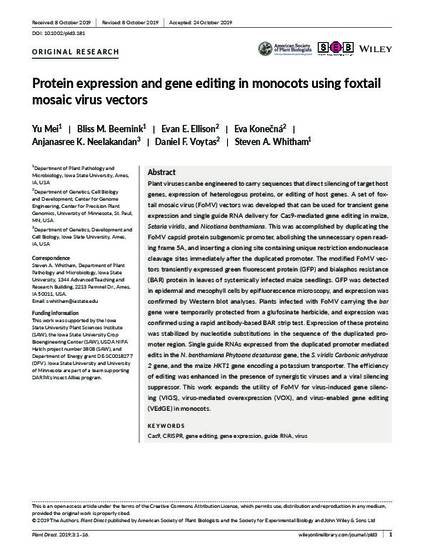
Plant viruses can be engineered to carry sequences that direct silencing of target host genes, expression of heterologous proteins, or editing of host genes. A set of foxtail mosaic virus (FoMV) vectors was developed that can be used for transient gene expression and single guide RNA delivery for Cas9‐mediated gene editing in maize, Setaria viridis, and Nicotiana benthamiana. This was accomplished by duplicating the FoMV capsid protein subgenomic promoter, abolishing the unnecessary open reading frame 5A, and inserting a cloning site containing unique restriction endonuclease cleavage sites immediately after the duplicated promoter. The modified FoMV vectors transiently expressed green fluorescent protein (GFP) and bialaphos resistance (BAR) protein in leaves of systemically infected maize seedlings. GFP was detected in epidermal and mesophyll cells by epifluorescence microscopy, and expression was confirmed by Western blot analyses. Plants infected with FoMV carrying the bar gene were temporarily protected from a glufosinate herbicide, and expression was confirmed using a rapid antibody‐based BAR strip test. Expression of these proteins was stabilized by nucleotide substitutions in the sequence of the duplicated promoter region. Single guide RNAs expressed from the duplicated promoter mediated edits in the N. benthamiana Phytoene desaturase gene, the S. viridis Carbonic anhydrase 2 gene, and the maize HKT1 gene encoding a potassium transporter. The efficiency of editing was enhanced in the presence of synergistic viruses and a viral silencing suppressor. This work expands the utility of FoMV for virus‐induced gene silencing (VIGS), virus‐mediated overexpression (VOX), and virus‐enabled gene editing (VEdGE) in monocots.
Available at: http://works.bepress.com/steven-whitham/50/

This article is published as Mei, Yu, Bliss M. Beernink, Evan E. Ellison, Eva Konečná, Anjanasree K. Neelakandan, Daniel F. Voytas, and Steven A. Whitham. "Protein expression and gene editing in monocots using foxtail mosaic virus vectors." Plant direct 3 (2019): e00181. doi: 10.1002/pld3.181.